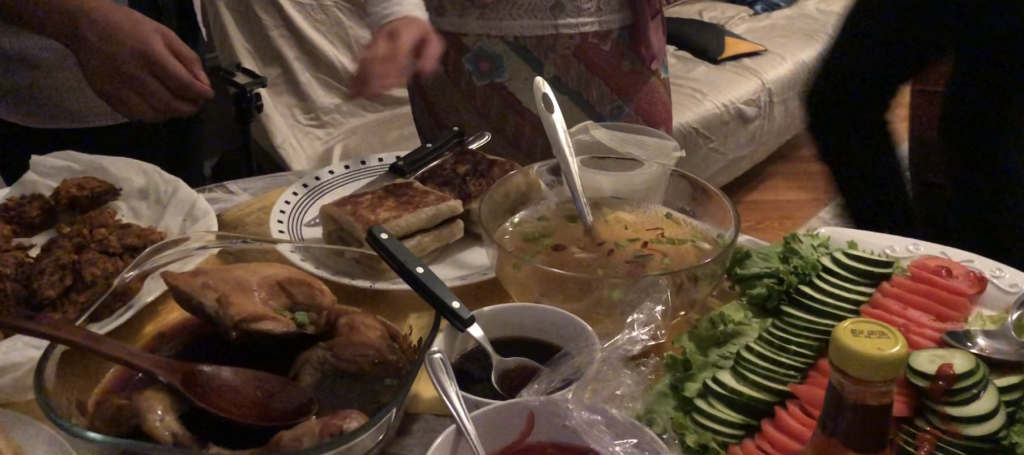This is a guest post from Shahirah Elaiza, creator of the Colours of My Life blog, and Colors of my Kitchen on Instagram.
As newlyweds living in Brooklyn, New York, Shahirah and Juan hosted their first iftar (a meal to break one’s fast) to celebrate the coming of Ramadan, the month of fasting with their friends.
Ramadan Reflections
Each year at Ramadan, we at Cultures Capsules look to showcase and celebrate various Ramadan traditions around the world. Some of our favorites include reflections of one Brooklyn family with roots in Palestine, an iftar meal with Nigerian chef in Manhattan, and a Malasian iftar with flair from several other spots on the globe, and of course, cookies from Tunisia.
If you want to share your story, contact us here!
story
Introduction
To make it a memorable experience for their friends who come from different parts of not just New York but the world, Shahirah created a Malaysian-themed iftar and prepared food and a music playlist that reflected her experience of Ramadan in Malaysia and New Zealand, where she resided for a substantial portion of her life. As an interracial and intercultural couple, Juan and Shahirah embraced their faith and cultures as part of their intertwining roots that help to ground them in their colorful life together.
story
Shahirah Reflects
I believe when things don’t always go according to plan it is life’s way of keeping things interesting for us. After all, that’s how I ended up moving to New York City nearly a year ago. I never expected to fall in love with a Juan, an Ecuadorian-American, let alone live in this soul-stirring metropolitan city.
However, diversity and multi-cultural seem to be a common thread in the cities I’ve found myself in, like Kuala Lumpur, Malaysia where I was born and raised, and Dunedin and Wellington, New Zealand, where I lived for a decade. As this is my first year of living in New York, many experiences feel new to me – from discovering shops and cafes in my Brooklyn neighborhood to observing Ramadan and having iftars in various boroughs of the city.
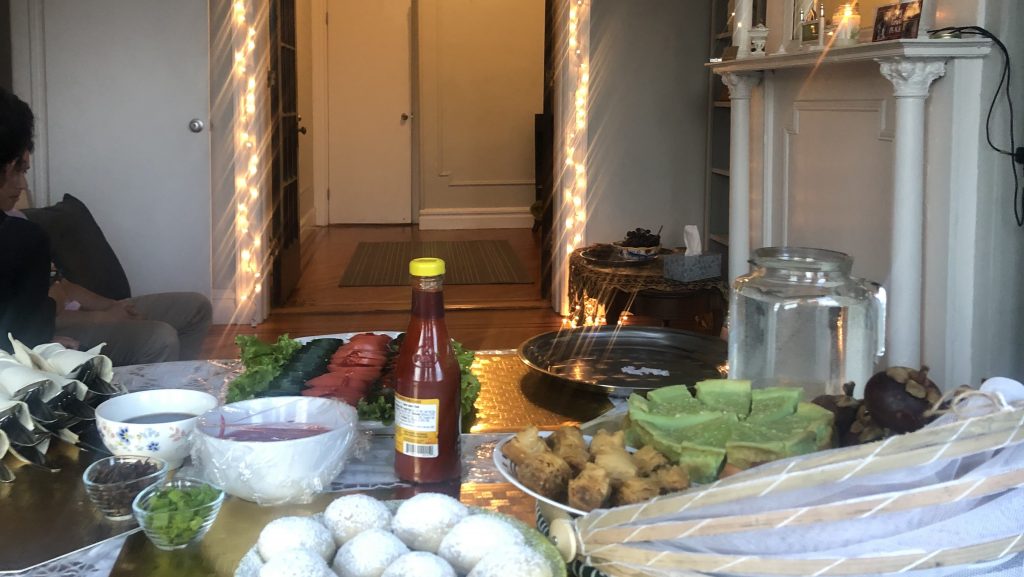
The sacred month of Ramadan is the most significant time of the year for many Muslims. We not only fast from food and water (yes, even water) from the start of sunrise to sunset, but we also focus on being more devoted to our Creator and serving our community. Apart from the usual daily routine, our schedules revolve around suhoor (pre-dawn meal), the 5 obligatory prayers and of course, iftar (a meal to break the fast). This is the time of the year when eating and drinking becomes an act of worship (getting bonus points for eating is awesome!) and providing food for others is a highly commendable act of love and worship.
“Whoever offers a meal to his/her Muslim brother/sister at the time of iftar), s/he receives as much reward as s/he has earned. Nothing becomes less of the reward of those s/he offered meal to.” – Prophet Muhammad (peace be upon him)
As someone who is still learning about Islam and someone who is new to New York, respectively, Juan and I decided to host an iftar in our home during Ramadan so we could learn about Islam and Muslims and our new friends in New York together. As newlyweds, hosting an iftar was also an opportunity for us to continue learning about each other and each other’s cultures.
On the 12th day of Ramadan (17th May 2019), we invited our friends to join us at home as we had an iftar with dishes that reflect my personal journey and Ramadan traditions from Malaysia and New Zealand while being serenaded by the recordings of gamelan, traditional instrumental Malay music.

It was an honor to share parts of my life story with my husband and friends during this iftar. Even though it was a lot of work before and after, it was worth it if they left feeling inspired to embrace their roots and uniqueness as their strengths and gifts that allow them to add beauty and color to the world… starting with this little corner in the world called New York city.
Juan and I find comfort, meaning and joy in understanding that various experiences shape us to become who we are, so naturally we will evolve, grow, hold on to traditions or create new ones. In sharing my journey from Malaysia to the United States, I hope our friends (and readers) can see unexpected as opportunities to become better and stronger. In sharing our journey as an interracial and intercultural couple, we hope others will be inspired to embrace love and faith and one’s unique roots and background, not as elements that absolutely define who we are, but as aspects of our identity that can create beauty and meaning in our lives and in the lives of others.

music
Malay Gamelan Music
“Everything was great. Right from the moment we entered [your home] and heard the music.”
D. on the gamelan music
The Malaysian experience wouldn’t be complete without traditional Malay gamelan music. The soothing sounds of these percussive instruments were played in the background as our friends enjoyed their iftar meal. Although the gamelan is originally from Indonesia, it has developed a distinctive sound in Malaysia, where it is traditionally played during royal occasions to welcome guests and audiences. Today, the gamelan is also played during formal and special occasions, such as university graduations and weddings.
Hearing the enchanting and regal melodies of the gamelan during our iftar brought back memories of our wedding reception in August 2018 and I felt like I was not only sharing my cultural tradition with our friends but also a part of Juan and I’s personal journey as husband and wife.
story
Breaking the Fast
As soon the adhan (call to prayer) was heard on our digital adhan player, everyone reached for a date (tamar in Arabic, kurma in Malay) to break their fast as it is a Prophetic tradition to break one’s fast with a date or sweet because sugar helps to restore energy. True to the Malaysian tradition of Ramadan, guests were also served the sirap cincau drink (rose syrup and grass jelly) to break their fast.
The menu for the evening was thoughtfully chosen and curated to represent pieces of my identity and/or a Ramadan tradition from Malaysia or New Zealand. (Which reminds me of something else that didn’t go according to plan in my life: growing up, I steered away from cooking Malaysian food because they tend to be complicated with so many spices, steps and techniques but ironically, I ended up marrying an American who likes Malaysian food, so I now find myself learning how to make Malaysian food and surprisingly enjoy it.)
recipe
Bubur Lambuk
“It tasted like a warm hug.”
S. on the bubur lambuk
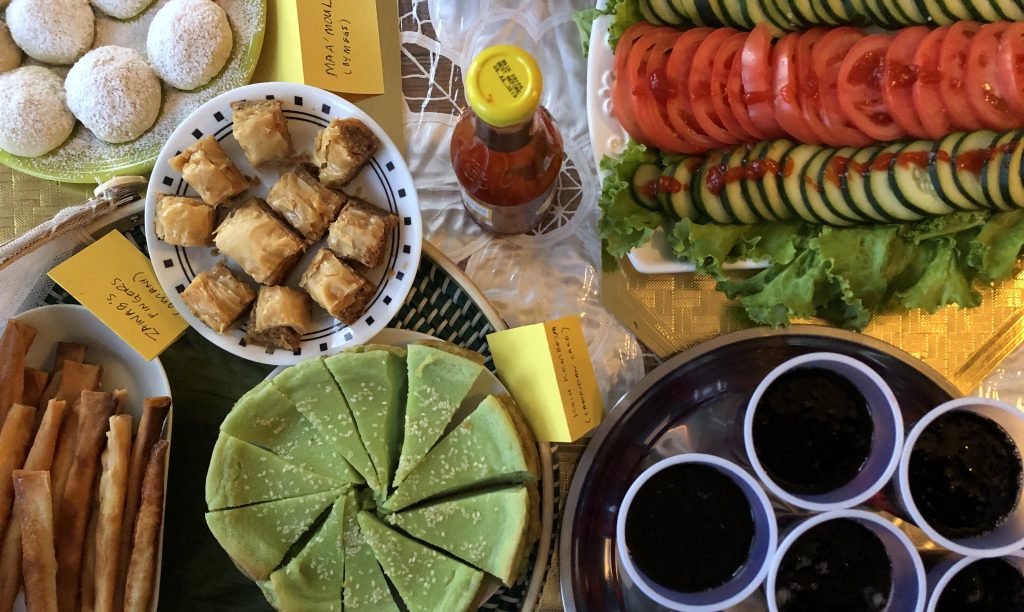
In Malaysia, bubur lambuk (Spiced Congee with Mince Beef and Peanuts) is synonymous with Ramadan because it is commonly distributed for free at mosques during this time of the year. The most well-known version of this spiced congee is called ‘Bubur Lambuk Masjid Jamek Kampung Baru’ in the heart of Kuala Lumpur. According to The Malay Mail, the tradition of preparing and distributing thousands of packets of bubur lambuk at Jamek Kampung Baru Mosque began in the 1920s:
“Legend has it that the Kampung Baru bubur lambuk recipe came from a man named Haji Said who brought the dish to share with a few of his companions during the breaking of fast at the mosque around 90 years ago.
It is said his friends fell in love with the dish and later asked that his wife make more of the porridge for them.
Word spread fast and more and more residents around the area started giving Haji Said and wife ingredients to make the bubur. As the reputation of his bubur lambuk and demand grew, the mosque decided that they would cook the dish as a staple, so that it could be distributed among those who break fast there.
The exact same recipe has been handed down four generations and the popularity of the Kampung Baru bubur lambuk has now spread beyond the city’s Malay enclave to as far as Singapore and Indonesia.”
Malay Mail
It began and still continues because Ramadan is a time of increased generosity and love for our community, and what better way to express these values than to prepare and give away a dish that consists of a Malaysian staple food – rice! (Malaysians eat rice everyday, sometimes 3 times a day.) Due to its distinctive flavor, bubur lambuk always seemed very complex to make but like many things, the fear of doing something is often scarier than actually doing it. I can’t believe I made bubur lambuk for my guests and they loved it!
Bubur Lambuk (Spiced Congee with Minced Beef and Peanuts)
Ingredients
- 2 tbsp ghee
- 3 tbsp vegetable oil
Spices A
- 1 cinnamon stick
- 3 cloves
- 1 star anise
- 2 cardamom seeds
- 1 tsp fenugreek
- 2 candlenuts, crushed with mortar and pestle
Spices B (bought whole and fried without oil and then ground in a food processor, or bought in ground form and then fried without oil separately before adding into the congee)
- 1 tsp fennel or cumin
- 1 tsp coriander
- 1 tsp white pepper
- 1 tsp black pepper
- 4 cloves garlic, minced
- 4 shallots, chopped
- 2 pandan (screwpine) leaves, washed and tied into a knot
- 1/2 cup dried shrimp, soaked in warm water and blended
- 1.1 lbs mince beef or 1 cm beef stir-fry pieces (equivalent to 1 kg)
- 1 inch ginger, peeled and sliced into matchsticks
- 2 cups white rice, rinsed (I used Jasmine)
- 1 cup water, or more as needed
Condiments (optional)
- 1/2 cup coriander, chopped
- 1/2 cup fried shallots
- salts and sugar to taste
Instructions
- Heat up ghee and vegetable oil on medium-high. Stir-fry Spices A and Spices B with garlic, pandan leaves and onions until it becomes fragrant.
- Add dried shrimp and continue to stir-fry.
- Add beef and stir-fry all the ingredients (including the ginger) until the beef browns and mixes well in the other ingredients.
- Add water and boil until the beef becomes slightly tender, especially if using stir-fry beef.
- Add rice to the mix. Add more water if the mixture is drying up. Simmer until the rice softens and the beef becomes completely tender. Add more water, if needed, and boil the rice. Once the water starts to boil, reduce the heat to medium-low and simmer until rice breaks down.
- Once the rice breaks down and looks like a congee, stir in the coconut milk. Then, season with salt (and a little sugar, if you like) according to your preference.
- Spoon into separate bowls and add condiments before serving.
recipe
Murtabak (Paratha with Minced Beef Filling)
In honor of my beloved late father, I prepared one of his favorite foods for the iftar. While it isn’t specific to Ramadan, I have seen murtabak sold at Ramadan food bazaars in Malaysia because it’s a popular dish until today.
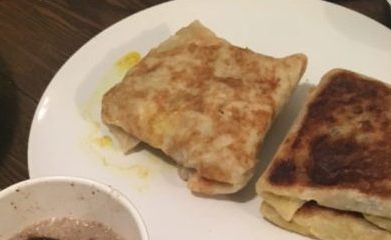
This paratha with meat filling not only reflects our Johorian heritage in the south of Malaysia (across the Singaporean straits) but also reflects his roots in Yemen from several generations ago. The murtabak is said to have originated from India and Yemen (‘mutabbiq’ means ‘folded’ in Arabic) and was brought over to South East Asia by Tamil Muslim traders and Hadhrami traders from Yemen in mid-18th Century.
During that time, the Straits of Johor was a popular port for traders. My father himself was a descendant of one these Hadhrami traders, many of whom were scholars of Islam who spread the message of Islam through trade around the world, including Malaya. It’s not impossible that these Yemeni traders also brought recipes and cuisines into Malaya.
In order to save time, I made a ‘cheat’ version of the murtabak by using frozen paratha instead of making it. I was able to find Malaysian-style paratha from my local supermarket but any plain paratha would suffice. All I had to do was prepare the meat filling and pickled onions. It would have also been ideal to serve dhal curry with it and I’ll be sure to do it next time!
Murtabak (Cheat Version)
Ingredients
- 2 tbsp vegetable oil
- 1.1 lbs minced beef equivalent to 500gm
- 2 medium yellow onions diced
- 3 tsp curry powder add more for extra spiciness
- salt and pepper to taste
- 1 packet Malaysian-style plain paratha 10 pieces in a packet
- 2 large eggs whisked
Instructions
- If frozen, de-frost paratha but not until it becomes too soft as it will make the paratha sticky. I de-frost them and keep them in the fridge until I'm ready to make the murtabak.
- Heat up oil in a non-stick pan.
- Brown the minced beef until there are no more clumps.
- Add onions and curry powder to the pan and fry together with the beef until onions soften.
- Season with salt and pepper.
- Once the minced beef filling mixture is well-done set aside. You may let the filling cool down and then keep it in the fridge until you're ready to serve your guests.
- In a separate pan, heat up half 1/2 teaspoon of vegetable oil and evenly spread on the pan. This step is optional but it creates a crispier murtabak.
- Place a de-frosted paratha on the pan.
- Spoon 1 tablespoon of the whisked egg onto the middle of the paratha and quickly put 1 – 2 tablespoons of minced beef filling on top of it.
- Fold the paratha to make a parcel of minced beef filling and brown one side until then turn it around to brown the other side.
- Remove from the pan and keep aside. Repeat until minced beef filling has finished.
- Serve the murtabak with lentil curry for a more tasty and satisfying meal.
music
Maghrib Adhan
During Ramadan, my family and I would gather around the dinner table and have the television switched on to hear the Maghrib adhan (call to prayer) as soon as it comes on. There is a joke among the Muslim community that Ramadan is the only time of the year when we know the exact time of Maghrib prayer right down to the minute and seconds because we are in full anticipation to break our fast.
Jokes aside, the adhan is not merely an invitation to the physical act of praying but an invitation to mentally and spiritually reconnect with our Creator and find peace in our daily lives. Clearly, I didn’t expect the adhan to be played on television here in the United States. Hence, as a substitute I brought a digital adhan player from Malaysia, which plays a recording of the call to prayer during designated prayer times. As soon as the Maghrib adhan was played our friends knew it was time to break their fast with some dates and/or water.
recipe
Kuih Bakar Kemboja (Baked Coconut Milk and Screwpine Cake)
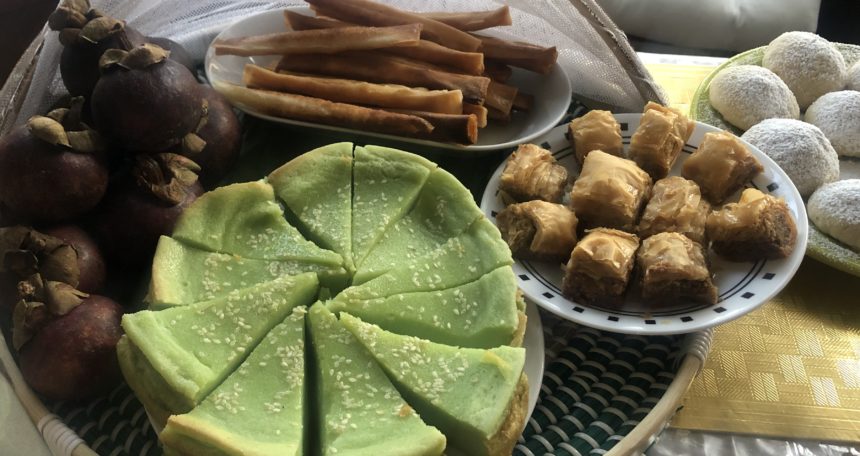
A meal is not complete without dessert. A particular dessert I served during for iftar was a traditional Malay kuih (cake) called kuih bakar kemboja, which literally translates to baked frangipani cake. The frangipani flower is known as ‘bunga kemboja’ in Malay and the cake is named after the flower because it’s traditionally made in a bronze mould shaped like a frangipani. (By the way, I don’t have a traditional frangipani-shaped bronze mould, so I used a round cake tin to make this cake).
I served this cake because it’s not very sweet and it has the soft texture of a baked custard cake, especially when it’s fresh out of the oven. Additionally, I used to call it ‘kuih hujan’ (raindrop cake) when I was a little girl because I didn’t know the name of the cake and the sesame seeds scattered on top of it looked like raindrops. One day, while walking through a Ramadan food bazaar I asked for ‘kuih hujan’ much to her confusion. It made sense to her when I pointed out the cake to her. Who would’ve thought someday I’d make ‘kuih hujan’ in New York city?
Our friends enjoyed the unique cake, thanks to ButterKicap.com’s recipe for the kuih bakar kemboja.
recipe
Zainab’s Fingers
One of my favorite desserts of all time is an Omani deep-fried pastry filled with cream cheese called Zainab’s fingers (asabe zainab in Arabic). Who is Zainab and why is there a dessert named after her? Find out more here.
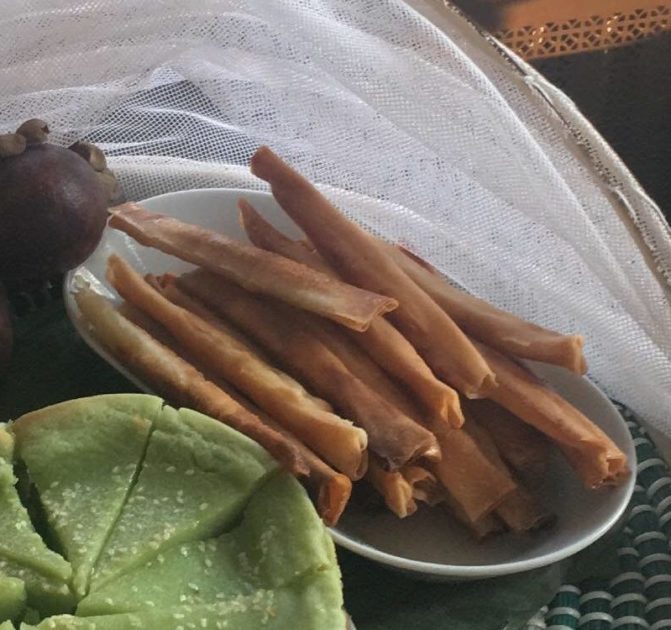
I first learned of Zainab’s fingers when my friends from Oman brought to the mosque in Dunedin, New Zealand for iftar during Ramadan. I was lucky enough to learn how to make them when I lived with a few Omani girls for three months, so decided to serve this dessert as a tribute to those wonderful memories we shared as friends and students in New Zealand.
Zainab’s Fingers
Ingredients
- 1 8 oz packet Philadelphia cream cheese
- 1 packet (10-pieces) Malaysian-style plain paratha
- 1 litre vegetable oil for deep-frying
Flour paste to seal the pastry
- 2 tbsp all-purpose flour
- 1 tsp water (or more, as needed)
Sugar syrup
- 1 cup water
- ½ cup caster sugar
- ½ cup honey
- 1 tbsp water
- 1 tbsp lemon juice
- 3 cardamom pods
Instructions
- De-frost spring roll pastry.
- Mix all-purpose flour and water to create a paste that will help to seal the pastry. Set aside.
- Prepare the sugar syrup by mixing all the ingredients. Once done, let it cool down and keep aside.
- Cut 2-inches long and 1-cm wide slice of the cream cheese and place at the top-center of the spring roll pastry. Fold the edges of the pastry to stop the cheese from leaking from the sides while frying and roll until the end. Seal and make the rest of the Zainab’s fingers. Dina demonstrates this process well in her video and I recommend watching it.
- Keep Zainab’s fingers in a fridge. You can prepare them early before frying them or just before frying them but it helps to keep them cool before frying in hot oil as it makes them very crispy.
- Heat oil to prepare for some serious deep-frying. Once the oil is hot, dip in the Zainab’s fingers and fry until both sides are golden brown, turning them as needed. Drain the oil by placing the Zainab’s fingers on paper towel after frying them.
- Drizzle the sugar syrup or dip every piece Zainab’s fingers with the sugar syrup and place them nicely on a plate. Pour a little more sugar syrup on top of the Zainab’s fingers before serving.
- Serve warm.
